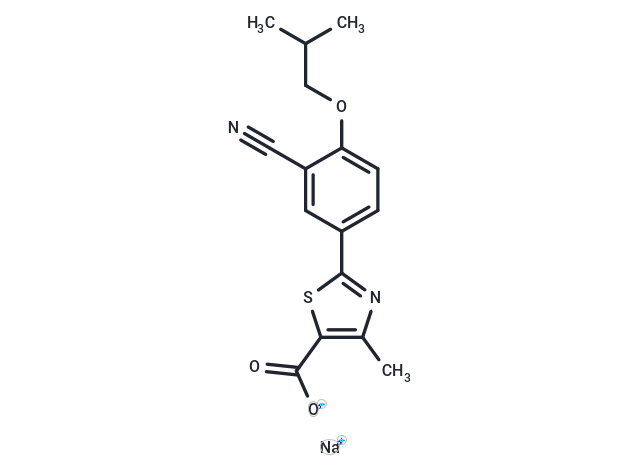Shopping Cart
Remove All Your shopping cart is currently empty
Your shopping cart is currently empty
Febuxostat (TEI 6720) sodium has the potential in gout and hyperuricemia research which is a potent, selective and non-purine inhibitor of xanthine oxidase (XO) with a Ki value of 0.6 nM [1] [2] [3].

| Pack Size | Price | USA Warehouse | Global Warehouse | Quantity |
|---|---|---|---|---|
| 25 mg | $1,520 | 1-2 weeks | 1-2 weeks | |
| 50 mg | $1,980 | 1-2 weeks | 1-2 weeks | |
| 100 mg | $2,500 | 1-2 weeks | 1-2 weeks |
| Description | Febuxostat (TEI 6720) sodium has the potential in gout and hyperuricemia research which is a potent, selective and non-purine inhibitor of xanthine oxidase (XO) with a Ki value of 0.6 nM [1] [2] [3]. |
| In vitro | Febuxostat sodium exhibits potent mixed-type inhibition against purified bovine milk xanthine oxidase, demonstrating inhibitory effects on both the oxidized and reduced forms of the enzyme, as evidenced by K i and K i ' values of 0.6 nM and 3.1 nM, respectively [1]. |
| In vivo | Febuxostat sodium, at varying dosages and treatment durations, has been observed to significantly mitigate adverse conditions in several experimental models. Administered daily at 5-6 mg/kg for 4 weeks to rats on a high-fructose diet (60% fructose) for 8 weeks, it substantially lowers glomerular pressure, renal vasoconstriction, and the afferent arteriolar area as compared to rats on the same diet without febuxostat, yet it does not affect rats on a standard diet [2]. A lower dose (3-4 mg/kg, orally) combined with oxonic acid (750 mg/kg, orally) for 4 weeks effectively prevents renal injury in 5/6 nephrectomy rats, with or without hyperuricemia [3]. Additionally, at 2.5 mg/kg taken orally for 12 weeks, it inhibits plaque formation in ApoE / mice and reduces ROS levels in the aortic walls of these atherosclerotic mice [4]. A higher dose (15.6 mg/kg, orally, once daily for 21 consecutive days) displays an antidepressant effect by significantly reducing immobility time in the Forced Swim Test in mice [5]. Moreover, when combined with doxorubicin at 10 mg/kg, orally, for 21 days, it greatly decreases nephrotoxicity markers and inflammatory mediators, restores normal oxidative stress biomarker values, and reduces renal caspase-3 expression [6]. |
| Molecular Weight | 338.36 |
| Formula | C16H15N2NaO3S |
| Cas No. | 1140907-13-6 |
| Smiles | [Na+].CC(C)COc1ccc(cc1C#N)-c1nc(C)c(s1)C([O-])=O |
| Storage | Powder: -20°C for 3 years | In solvent: -80°C for 1 year | Shipping with blue ice/Shipping at ambient temperature. |
| Size | Quantity | Unit Price | Amount | Operation |
|---|

Copyright © 2015-2026 TargetMol Chemicals Inc. All Rights Reserved.